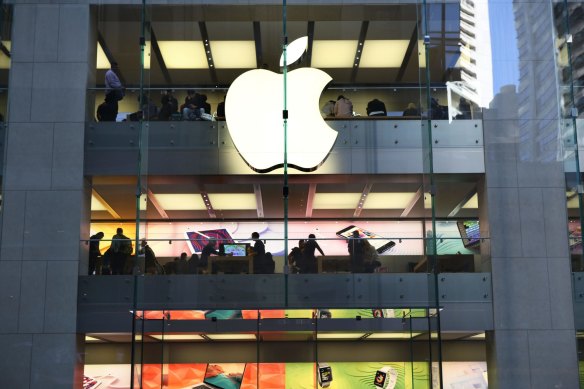
Apple once had a head start in AI services. It released the Siri digital assistant in 2011, beating Amazon’s Alexa and the Google Assistant to the market. But it soon fell behind rivals, and that was before a seismic shift in 2022 when ChatGPT debuted.
The introduction of OpenAI’s chatbot in November of that year captured the imagination of consumers and sent tech giants scrambling to develop their own AI services. Apple’s biggest peers have all made headway since then. Google’s Gemini chatbot is vying with ChatGPT for supremacy in the nascent market. Microsoft, OpenAI’s biggest backer, has begun weaving its AI-assisted Copilot into software. And Amazon.com has demonstrated an AI-enhanced version of Alexa.

Apple is racing to catch up to its rivals in AI.Credit: James Alcock
In contrast, Apple kept its AI ambitions quiet until now. Cook said last year that the company would tread carefully in the new space and only add AI technology on a “very thoughtful basis”. More recently, he’s argued that Apple will have an edge in AI because of its “unique combination of seamless hardware, software and services integration”.
Behind the scenes, Apple employees have been working furiously to back up that promise. Around the time of the ChatGPT launch, small teams within the company’s AI and software engineering divisions began working on a competitor to ChatGPT, using a framework dubbed Ajax.
Software chief Craig Federighi pushed managers to pack the latest version of the iPhone and iPad operating system – known internally as “Crystal” – with as much AI as possible. Eddy Cue’s services division got to work on new data centre infrastructure for powering online AI services. Staffers also began investigating how AI could come to Apple Music and the company’s office-productivity apps.
Loading
Apple found that its AI is capable enough to power features such as voice memo transcriptions and photo editing, as well as new search capabilities in the Safari web browser and auto replies in apps like Messages. But it determined early on that OpenAI and Google were far ahead in chatbots and on-the-fly assistance.
That put Apple in a difficult spot. The company’s own technology wasn’t ready, and executives were concerned about reputational damage from a rogue chatbot. Some people within Apple even have a philosophical aversion to having a chatbot at all, people familiar with the situation have said.
But it was clear by then that consumers would expect Apple to offer such a service, and that set the company on the path to its deal with OpenAI. Several months ago, the company began meeting with the start-up – along with Google and other chatbot providers – about integrating the technology into its iOS software.
By outsourcing the chatbot function, Apple can distance itself from the technology itself, including its occasional inaccuracies and hallucinations, the people said. But it also links Apple to a start-up beset by upheaval and controversy. Altman, now 39, was briefly ousted last year for reasons that remain murky, and he recently drew the ire of movie star Scarlett Johansson for a soundalike AI voice.
Though Apple remains in talks with Google about using Gemini in its devices, the iPhone maker reached an agreement with OpenAI first. In the end, Apple may offer a number of third-party chatbots, but it’s negotiating the deals on a case-by-case basis, according to the people with knowledge of the situation.
Apple picked OpenAI as its inaugural AI partner for a few reasons, one of the people said. It got better business terms than Google was offering, and Apple believes that OpenAI’s technology is the best available on the market. Integrating Google AI into the iPhone also might have given the impression that Apple’s biggest technology rival had beat it in a vital new area.
OpenAI, meanwhile, will get the gigantic exposure that comes with being deeply integrated into some of the world’s best-selling smartphones and tablets. Still, Apple’s involvement may bring new scrutiny to the safety and privacy concerns swirling around ChatGPT. Depending on how deeply Apple plans to integrate the chatbot with its software, it also could mean that OpenAI has access to personal information, which could unnerve some users.
But Apple is expected to offer its new AI features as an opt-in service, according to the people familiar with the matter. So wary customers could easily steer clear of them if they’d prefer.
Regardless, the OpenAI agreement is likely a stopgap measure. Apple has a long history of eventually bringing outside technology in-house, such as when it replaced Intel chips with its own silicon.
Loading
Apple also is looking beyond chatbots. It aims to use large language models – a key technology behind generative AI – to help power a pair of robotic devices that it is secretly developing, the people said.
That includes a table-top robotic arm with a large, iPad-like display. The company also has been working on a mobile robot that can follow users around and handle chores on their behalf. And it’s looking to equip its AirPods with cameras and AI features.
More immediately, there’s the opportunity for Siri to finally live up to its potential, Kittlaus said. That could bring some vindication to a company that hatched the dream of a smart personal assistant under co-founder Steve Jobs.
“There are no longer any technical constraints to realising the original Siri vision,” Kittlaus said.
Bloomberg
The Business Briefing newsletter delivers major stories, exclusive coverage and expert opinion. Sign up to get it every weekday morning.



























